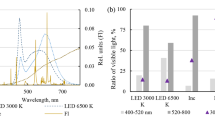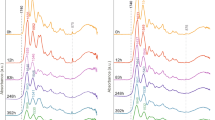Abstract
THE importance of oxygen and water vapour on the photosensitized degradation of textile fibres by near ultra-violet and visible light has been demonstrated 1 ; but the effect of temperature on these reactions has received little attention. Because of the fluctuating intensity of sunlight and consequently the difficulty of accurate temperature control, we have used in our experiments an artificial light source (400-W high-pressure mercury-vapour lamp), which has been shown1 to produce qualitative results similar to those of sunlight. The textile fibres were exposed in the form of yarns in the interior portion of a double-walled glass cell (diam., 1.5 in. int., 2.0 in. ext.). The temperature of the cell was controlled by passing water or steam continuously through the annular space. Dry air pre-warmed to the requisite temperature was passed continuously through the central portion of the cell at 0 per cent relative humidity, and a quantity of water not in contact with the fibre was maintained at the bottom of the cell at 100 per cent relative humidity. For the short exposure periods involved in these experiments the thermal degradation occurring in the dark was negligible.
Similar content being viewed by others
References
Egerton, G. S., J. Soc. Dyers Col., 63, 161 (1947); 65, 764 (1949); J. Text. Inst., 39, T293 and T305 (1948).
Author information
Authors and Affiliations
Rights and permissions
About this article
Cite this article
EGERTON, G., SHAH, K. Effect of Temperature on the Photosensitized Degradation of Textile Fibres. Nature 202, 81–82 (1964). https://doi.org/10.1038/202081b0
Issue Date:
DOI: https://doi.org/10.1038/202081b0
- Springer Nature Limited
This article is cited by
-
Photosensitizing Properties of Dyes and White Pigments
Nature (1964)





